Allergy Asthma Respir Dis.
2017 Jan;5(1):21-26. 10.4168/aard.2017.5.1.21.
Colonization of Staphylococcus aureus and sensitivity to antibiotics in children with atopic dermatitis
- Affiliations
-
- 1Department of Pediatrics, Busan St. Mary's Hospital, Busan, Korea. hyh190@naver.com
- KMID: 2368572
- DOI: http://doi.org/10.4168/aard.2017.5.1.21
Abstract
- PURPOSE
Staphylococcus aureus colonization exacerbates atopic dermatitis. Local or systemic antibiotics can increase difficulty in controlling skin colonization and the possibility of methicillin-resistant S. aureus (MRSA). Choosing appropriate antibiotics has become more challenging. We investigated the frequency of S. aureus and MRSA colonization and susceptibility to antimicrobial agents.
METHODS
We collected and cultivated the skin colonization samples of atopic dermatitis children less than 20 years old from June 2006 to May 2016, and tested the antibiotic sensitivity. We also checked the severity of atopic dermatitis by SCORing Atopic Dermatitis (SCORAD) index and analyzed.
RESULTS
Out of 2,355 subjects, 1,935 (82.2%) had S. aureus and 762 (39.4%) had MRSA. The frequency of MRSA increased from 13.3% in 2006 to 26.6% in 2007, 18.4% in 2008, 27.1% in 2009, 38.3% in 2010, 42.6% in 2011, 42.4% in 2012, 48.3% in 2013, 44.5% in 2014, 38.1% in 2015, and 37.5% in 2016. Mupirocin resistance started with 0% in 2009, and gradually increased annually to 13.7% in 2010, 14.7% in 2011, 25.4% in 2012, 35.2% in 2013, 34.9% in 2014, 39.8% in 2015, and 35.6% in 2016. The mupirocin resistant group has a higher SCORAD index than the other groups (P<0.05).
CONCLUSION
MRSA frequency and mupirocin resistance tended to increase annually. We should choose the methods of managing bacterial colonization in atopic dermatitis carefully in order to prevent antibiotic resistance.
MeSH Terms
Figure
Cited by 2 articles
-
Changing Susceptibility of Staphylococcus aureus in Children with Skin and Soft Tissue Infections: a Single Center Experience from 2010 to 2018
Yong-Sun Cho, Shin-Hye Lee, Taek-Jin Lee
Pediatr Infect Vaccine. 2019;26(3):140-147. doi: 10.14776/piv.2019.26.e22.Molecular Epidemiologic Study of a Methicillin-resistant Staphylococcus aureus Outbreak at a Newborn Nursery and Neonatal Intensive Care Unit
Hyun Mi Kang, Ki Cheol Park, Kyung-Yil Lee, Joonhong Park, Sun Hee Park, Dong-Gun Lee, Jong-Hyun Kim
Pediatr Infect Vaccine. 2019;26(3):148-160. doi: 10.14776/piv.2019.26.e23.
Reference
-
1. Hanifin J, Rajka G. Diagnostic features of atopic eczema. Acta Dermatol Venereol (Stockh). 1980; 92:44–47.2. Roesch A, Linde HJ, Landthaler M, Vogt T. Elimination of a community-acquired methicillin-resistant Staphylococcus aureus infection in a nurse with atopic dermatitis. Arch Dermatol. 2005; 141:1520–1522.
Article3. Hon KL, Leung AK, Kong AY, Leung TF, Ip M. Atopic dermatitis complicated by methicillin-resistant Staphylococcus aureus infection. J Natl Med Assoc. 2008; 100:797–800.
Article4. Suh LM, Honig PJ, Yan AC. Methicillin-resistant Staphylococcus aureus skin abscesses in a pediatric patient with atopic dermatitis: a case report. Cutis. 2006; 78:113–116.5. Foster TJ. Immune evasion by staphylococci. Nat Rev Microbiol. 2005; 3:948–958.
Article6. McFadden JP, Noble WC, Camp RD. Superantigenic exotoxin-secreting potential of staphylococci isolated from atopic eczematous skin. Br J Dermatol. 1993; 128:631–632.
Article7. Leung DY, Harbeck R, Bina P, Reiser RF, Yang E, Norris DA, et al. Presence of IgE antibodies to staphylococcal exotoxins on the skin of patients with atopic dermatitis. Evidence for a new group of allergens. J Clin Invest. 1993; 92:1374–1380.
Article8. Calfee DP. Methicillin-resistant Staphylococcus aureus and vancomycin-resistant enterococci, and other Gram-positives in healthcare. Curr Opin Infect Dis. 2012; 25:385–394.
Article9. Mediavilla JR, Chen L, Mathema B, Kreiswirth BN. Global epidemiology of community-associated methicillin resistant Staphylococcus aureus (CA-MRSA). Curr Opin Microbiol. 2012; 15:588–595.
Article10. Hill SE, Yung A, Rademaker M. Prevalence of Staphylococcus aureus and antibiotic resistance in children with atopic dermatitis: a New Zealand experience. Australas J Dermatol. 2011; 52:27–31.
Article11. Hoeger PH. Antimicrobial susceptibility of skin-colonizing S. aureus strains in children with atopic dermatitis. Pediatr Allergy Immunol. 2004; 15:474–477.
Article12. Niebuhr M, Mai U, Kapp A, Werfel T. Antibiotic treatment of cutaneous infections with Staphylococcus aureus in patients with atopic dermatitis: current antimicrobial resistances and susceptibilities. Exp Dermatol. 2008; 17:953–957.
Article13. Tang CS, Wang CC, Huang CF, Chen SJ, Tseng MH, Lo WT. Antimicrobial susceptibility of Staphylococcus aureus in children with atopic dermatitis. Pediatr Int. 2011; 53:363–367.
Article14. Suh L, Coffin S, Leckerman KH, Gelfand JM, Honig PJ, Yan AC. Methicillin-resistant Staphylococcus aureus colonization in children with atopic dermatitis. Pediatr Dermatol. 2008; 25:528–534.
Article15. Chung HJ, Jeon HS, Sung H, Kim MN, Hong SJ. Epidemiological characteristics of methicillin-resistant Staphylococcus aureus isolates from children with eczematous atopic dermatitis lesions. J Clin Microbiol. 2008; 46:991–995.
Article16. Matlow A, Forgie S, Pelude L, Embree J, Gravel D, Langley JM, et al. National surveillance of methicillin-resistant Staphylococcus aureus among hospitalized pediatric patients in Canadian acute care facilities, 1995-2007. Pediatr Infect Dis J. 2012; 31:814–820.
Article17. Bath-Hextall FJ, Birnie AJ, Ravenscroft JC, Williams HC. Interventions to reduce Staphylococcus aureus in the management of atopic eczema: an updated Cochrane review. Br J Dermatol. 2010; 163:12–26.
Article18. Shah M, Mohanraj M. High levels of fusidic acid-resistant Staphylococcus aureus in dermatology patients. Br J Dermatol. 2003; 148:1018–1020.
Article19. Ravenscroft JC, Layton A, Barnham M. Observations on high levels of fusidic acid resistant Staphylococcus aureus in Harrogate, North Yorkshire, UK. Clin Exp Dermatol. 2000; 25:327–330.
Article20. Andersen BM, Bergh K, Steinbakk M, Syversen G, Magnaes B, Dalen H, et al. A Norwegian nosocomial outbreak of methicillin-resistant Staphylococcus aureus resistant to fusidic acid and susceptible to other antistaphylococcal agents. J Hosp Infect. 1999; 41:123–132.
Article21. Brown EM, Thomas P. Fusidic acid resistance in Staphylococcus aureus isolates. Lancet. 2002; 359:803.22. Yun HJ, Lee SW, Yoon GM, Kim SY, Choi S, Lee YS, et al. Prevalence and mechanisms of low- and high-level mupirocin resistance in staphylococci isolated from a Korean hospital. J Antimicrob Chemother. 2003; 51:619–623.
Article23. Park SY, Kim SM, Park SD. The prevalence, genotype and antimicrobial susceptibility of high- and low-level mupirocin resistant methicillin-resistant Staphylococcus aureus. Ann Dermatol. 2012; 24:32–38.
Article24. Lever R, Hadley K, Downey D, Mackie R. Staphylococcal colonization in atopic dermatitis and the effect of topical mupirocin therapy. Br J Dermatol. 1988; 119:189–198.
Article25. Fisher RG, Chain RL, Hair PS, Cunnion KM. Hypochlorite killing of community-associated methicillin-resistant Staphylococcus aureus. Pediatr Infect Dis J. 2008; 27:934–935.
Article26. Winter J, Ilbert M, Graf PC, Ozcelik D, Jakob U. Bleach activates a redox-regulated chaperone by oxidative protein unfolding. Cell. 2008; 135:691–701.
Article27. Lipnharski C, d'Azevedo PA, Quinto VP, Bessa G, Bonamigo RR. Colonization by S. aureus increases the EASI and the number of appointments by patients with atopic dermatitis: cohort with 93 patients. An Bras Dermatol. 2013; 88:518–521.
Article
- Full Text Links
- Actions
-
Cited
- CITED
-
- Close
- Share
- Similar articles
-
- The association between Staphylococcus aureus colonization and food sensitization in children with atopic dermatitis
- Interactions Between Atopic Dermatitis and Staphylococcus aureus Infection: Clinical Implications
- The role of antiseptic agents in atopic dermatitis
- A Quantitative Culture Study of Staphylococcus aureus in Adolescent and Adult Patients with Atopic Dermatitis using the Contact-plate Sampling Technique
- Two Cases of Infective Endocarditis in Patients with Atopic Dermatitis






